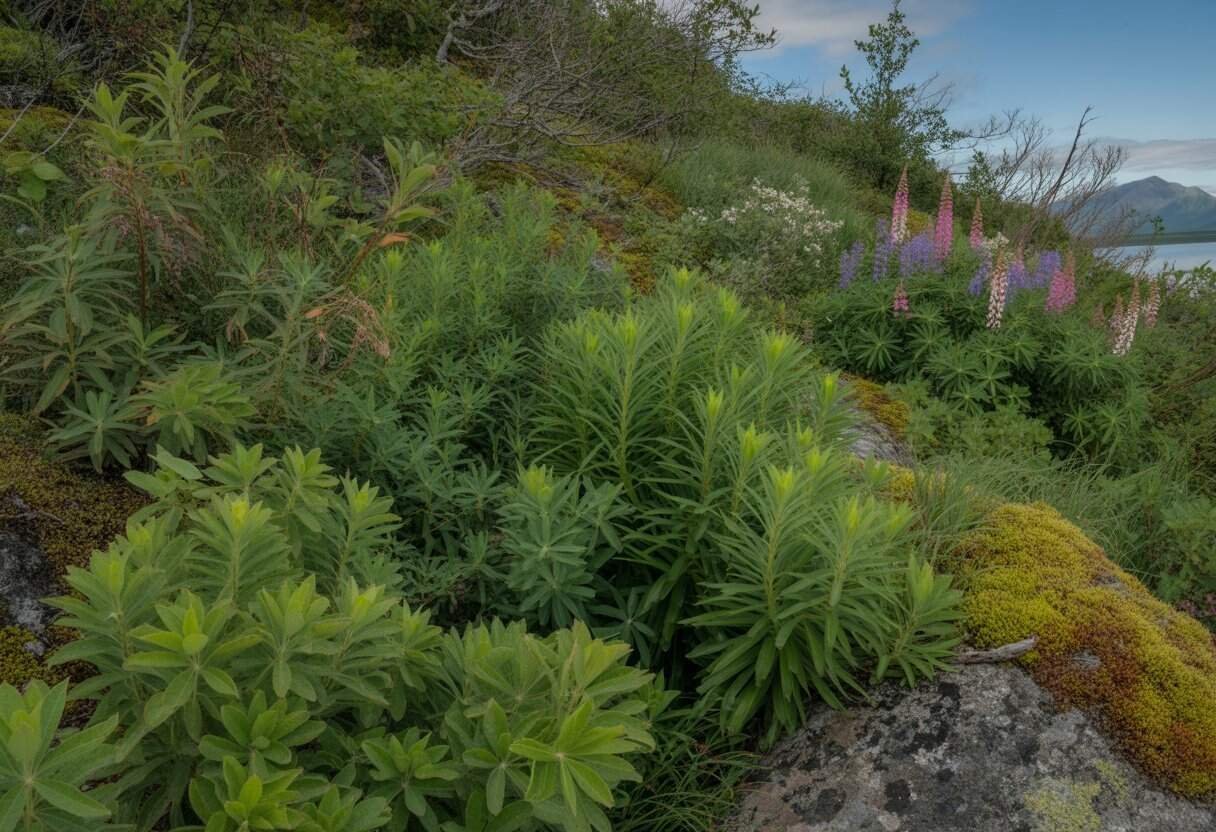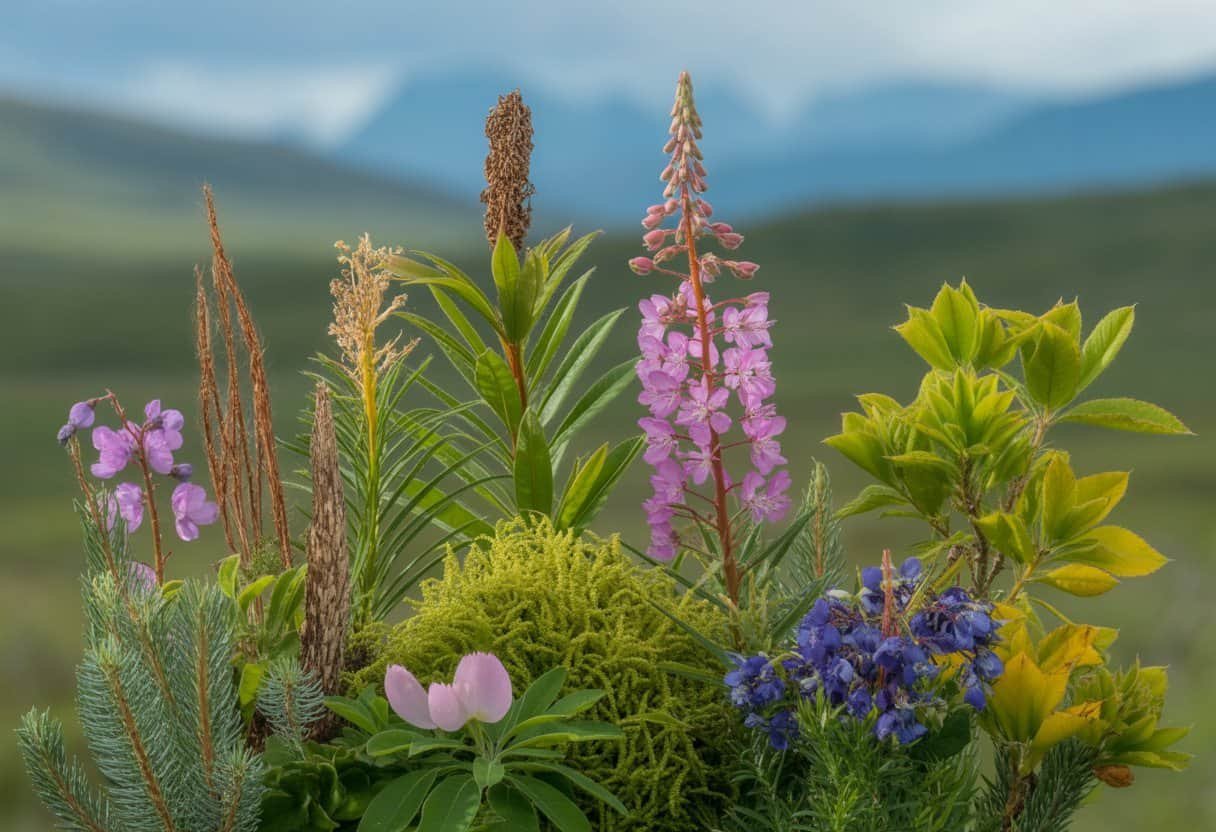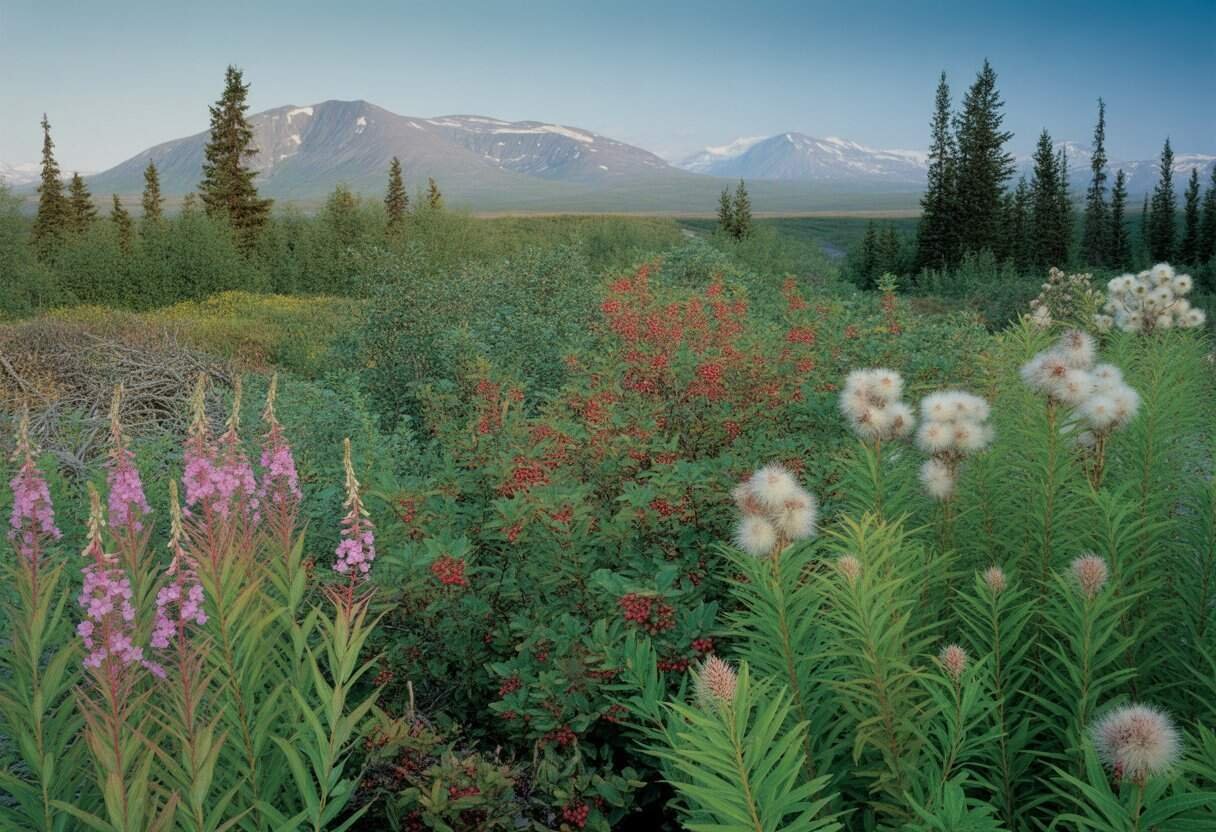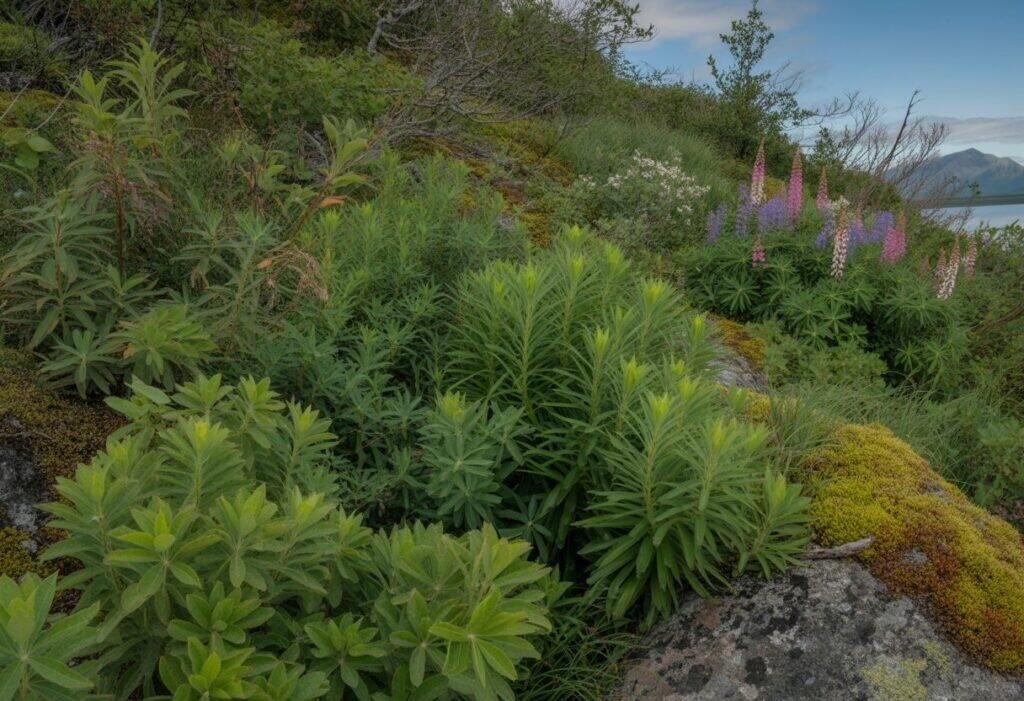Alaska’s native plants are remarkable survivors that have adapted to some of the harshest conditions on Earth. From towering spruce trees to tiny tundra flowers, these plants have developed unique strategies to thrive in cold temperatures, short growing seasons, and nutrient-poor soils.

Alaska’s indigenous flora includes over 1,700 plant species, many of which are found nowhere else in the world. These specialized plants provide essential habitat for wildlife, prevent soil erosion, and have sustained Alaska Native peoples for thousands of years through food, medicine, and materials.
Exploring Alaska’s native plants offers a window into the balance of northern ecosystems. These resilient species tell stories of glacial retreats, climate shifts, and human relationships with the land.
Key Takeaways
- Alaska native plants have unique adaptations that allow them to survive extreme northern conditions.
- Indigenous flora provides critical habitat for wildlife while holding cultural and practical significance for Alaska Native peoples.
Overview of Alaska Native Plants
Alaska’s diverse landscape supports a remarkable array of native plants adapted to survive in some of North America’s harshest conditions. These species have evolved special characteristics to thrive in the state’s unique climate and geography.
Defining Native Plants
Native plants in Alaska are species that evolved naturally in the region without human introduction. They have existed in Alaska’s ecosystems for thousands of years, developing alongside local wildlife, insects, and microorganisms.
These plants are perfectly adapted to Alaska’s short growing seasons, cold temperatures, and varying soil conditions. Native species like fireweed, wild blueberry, and Sitka spruce have developed specific survival mechanisms.
Some use antifreeze compounds in their cells to prevent frost damage. Others grow low to the ground to avoid harsh winds.
Alaska native plants require less maintenance than introduced species. They don’t need fertilizers or pesticides to thrive in their natural habitat.
This makes them valuable for restoration projects and sustainable landscaping across the state.
Alaska’s Unique Ecosystems
Alaska contains several distinct ecosystems that support different native plant communities. The coastal rainforests of Southeast Alaska host towering Sitka spruce, western hemlock, and lush understory plants like devil’s club and ferns.
The interior boreal forest features black and white spruce, paper birch, and aspen. These trees have adapted to extreme temperature fluctuations and permafrost conditions.
Alpine tundra ecosystems showcase colorful wildflowers like lupine, forget-me-nots (Alaska’s state flower), and hardy dwarf willows. These plants complete their life cycles quickly during the brief summer.
Wetlands and muskeg areas support unique plant communities including cloudberries, labrador tea, and specialized sedges. These plants have adapted to waterlogged, acidic conditions.
Biodiversity and Natural Beauty
Alaska’s native flora adds to the state’s famous natural beauty. During the short summer, wildflower displays create panoramas of color across mountain meadows and tundra plains.
The brilliant purple of fireweed marks the progression of summer. Vibrant blue lupines and magenta shooting stars add dramatic displays against green backgrounds.
Fall brings yellow and red foliage as deciduous plants prepare for winter. This botanical diversity supports Alaska’s wildlife.
Berries feed bears and birds, while willows provide food for moose. Many plants also hold cultural significance for Alaska Native peoples, who have used them for food, medicine, and materials for generations.
Major Types of Alaska Native Flora

Alaska’s unique environment supports diverse plant life adapted to harsh conditions. Native plants have evolved special features to survive long winters, short growing seasons, and challenging soils.
Common Trees of Alaska
Sitka spruce dominates Southeast Alaska’s coastal forests, reaching heights of 180 feet with distinctive scaly bark and sharp needles. This hardy tree provides important habitat for wildlife and has historically been used for building canoes and homes.
Western hemlock often grows alongside Sitka spruce in rainforest areas. It has flat, blunt needles and drooping branch tips.
This shade-tolerant tree can live for over 500 years. Paper birch is common in interior Alaska, recognized by its white, peeling bark.
These trees thrive after forest fires, quickly colonizing burned areas. Black spruce grows in boggy areas with poor soil.
Despite its small size (rarely over 40 feet), it survives in permafrost conditions where other trees cannot.
Characteristic Shrubs
Arctic willow is a small shrub growing just 2-3 inches tall in tundra regions. Its adaptation to harsh conditions includes growing horizontally to avoid wind damage.
Blueberry shrubs are widespread across Alaska. They produce nutritious berries that sustain wildlife and people.
Low-bush blueberries carpet forest floors, while high-bush varieties form thickets in wetter areas. Labrador tea grows in boggy areas and has leathery leaves with rusty-colored undersides.
Native Alaskans have traditionally used its leaves to make tea with medicinal properties. Salmonberry thrives in coastal regions, producing orange-red berries that resemble raspberries.
Its bright pink flowers appear early in spring, providing nectar for pollinators.
Wildflowers and Groundcovers
Fireweed is Alaska’s most iconic wildflower. It quickly colonizes areas after fires and its tall pink-purple flower spikes brighten roadsides and clearings throughout summer.
Forget-me-not, Alaska’s state flower, produces delicate blue blooms with yellow centers. These small flowers grow in alpine meadows and rocky areas, often appearing soon after snowmelt.
Dwarf dogwood (bunchberry) creates carpets of green in forest understories. Small white “flowers” (actually modified leaves) surround the true tiny flowers in the center, later developing into bright red berries.
Alpine azalea forms low mats in tundra environments and produces tiny pink bell-shaped flowers. Despite standing just an inch tall, these hardy plants can live for decades in exposed mountain sites.
Habitats and Regional Variation

Alaska’s diverse landscape supports a variety of plant communities adapted to specific environmental conditions. These plant communities have evolved unique characteristics to thrive in their respective habitats across the state’s vast territory.
Taiga and Boreal Forests
The taiga, or boreal forest, covers much of interior Alaska and represents the largest terrestrial ecosystem in the state. This habitat features cold-adapted trees like black spruce, white spruce, and paper birch that can withstand harsh winter conditions.
Black spruce dominates in poorly drained areas with permafrost, while white spruce prefers warmer, better-drained sites. Paper birch and aspen create bright patches following forest fires.
The forest floor hosts a variety of smaller plants including lowbush cranberry, lingonberry, and feathermosses. These species form important understory communities that provide food and shelter for wildlife.
Many taiga plants have developed specialized adaptations like waxy coatings on leaves to reduce moisture loss during winter.
Coastal Rainforests
Southeast Alaska’s coastal areas support temperate rainforests with high precipitation and moderate temperatures. These lush forests contain Sitka spruce, western hemlock, and red cedar that grow to impressive heights.
The forest understory features dense growth of devil’s club, salmonberry, and various ferns. Mosses blanket the forest floor and drape from tree branches, creating a distinctive emerald appearance.
Key Coastal Rainforest Plants:
- Sitka spruce (Picea sitchensis)
- Western hemlock (Tsuga heterophylla)
- Devil’s club (Oplopanax horridus)
- Salmonberry (Rubus spectabilis)
These rainforests support the highest biomass per acre of any habitat in Alaska.
Arctic and Alpine Zones
In the far north and at high elevations like Denali, plants must survive extreme cold, strong winds, and a very short growing season. Arctic and alpine plants typically grow low to the ground to avoid wind damage and capture heat.
Arctic willow rarely grows more than a few inches tall despite being technically a “tree.” Dwarf birch forms dense mats that help insulate the soil beneath.
Colorful wildflowers like mountain avens, Arctic poppy, and forget-me-not (Alaska’s state flower) create brief but stunning displays during the short summer. These plants often have larger flowers relative to their size to attract pollinators quickly.
Many alpine plants in Denali National Park display circumpolar distribution, meaning they’re found across northern regions around the world.
Wetlands and Riverbanks
Alaska’s abundant wetlands and riverbanks support specialized plant communities adapted to saturated soils. Sedges, rushes, and cotton grass dominate these areas, creating important habitat for migratory birds.
Floating and emergent plants like pond lilies and buckbean thrive in standing water. Along riverbanks, willows and alders form dense thickets that help stabilize soil and prevent erosion during spring floods.
Many wetland plants have developed specialized root structures that allow them to obtain oxygen in waterlogged soils. These adaptations include air channels called aerenchyma tissue.
Wetland plants filter water, provide wildlife habitat, and store carbon in accumulated peat deposits.
Wildlife Interactions and Ecosystem Importance
Alaska’s native plants create the foundation for diverse ecosystems across the state. These plants form critical relationships with wildlife while maintaining landscape health.
Native Plants and Alaskan Wildlife
Alaska’s wildlife depends on native plants for survival. Bears feast on salmonberries and blueberries in summer to build fat reserves for winter hibernation.
Moose browse on willows and birch, consuming up to 60 pounds of vegetation daily. Ptarmigan rely on dwarf birch for both food and shelter.
These birds eat the buds and catkins while using the shrubs for protection from predators and harsh weather. Pollinators like bumblebees and butterflies have co-evolved with native flowers like fireweed and wild geranium.
These relationships are precisely timed—when fireweed blooms, certain butterfly species emerge to feed on its nectar. Small mammals including voles and pikas collect seeds and vegetation for winter caches, spreading plant species across the landscape.
Supporting Plants and Wildlife
Native plants provide crucial habitat structure in Alaska’s ecosystems. The layered vegetation in spruce forests creates multiple niches where different species thrive.
Key Wildlife Support Functions:
- Food sources (berries, seeds, leaves, roots)
- Nesting materials and sites
- Winter shelter and insulation
- Migration landmarks and corridors
Alpine plants like moss campion create microhabitats that shelter insects and small mammals from harsh winds. These tiny ecosystems become feeding grounds for birds.
Wetland plants such as sedges and cottongrass filter water while providing nesting habitat for waterfowl. Millions of migratory birds depend on these healthy wetland systems during breeding season.
Role in Landscape Health
Native plants maintain Alaska’s landscape integrity through soil stabilization and nutrient cycling. Their extensive root systems prevent erosion on steep slopes and riverbanks.
In tundra regions, plants like dwarf willow and crowberry form the living foundation that supports the entire ecosystem. These plants survive extreme conditions while building soil organic matter.
After wildfires, pioneer species such as fireweed and alder quickly colonize the area. They fix nitrogen in the soil and create shade for forest regeneration.
Native plant communities buffer against climate fluctuations by regulating water flow and soil temperature. Moss layers in boreal forests insulate the ground and help maintain permafrost stability.
Healthy native plant populations support biodiversity across all trophic levels, from soil microbes to top predators.
Cultural and Historical Significance
Alaska Native plants have shaped the lives of indigenous peoples for thousands of years. These plants provided food, medicine, tools, and spiritual connections.
Indigenous Knowledge and Uses
Alaska Native tribes developed extensive knowledge of local plants through generations of observation and use. Devil’s club (Oplopanax horridus) served as an important medicinal plant for treating ailments like diabetes, respiratory issues, and pain.
Its spiny bark and roots were carefully harvested following traditional protocols. Berries such as salmonberries, blueberries, and cranberries provided essential vitamins during long winters.
Communities often preserved these fruits by drying or mixing them with fish oil to create “Eskimo ice cream” (akutaq). Woven baskets and mats used plants like beach ryegrass and spruce roots.
The Tlingit and Haida people developed sophisticated techniques for harvesting and weaving these materials into functional and artistic items.
Traditional Ecological Practices
Alaska Native communities practiced sustainable harvesting methods. These approaches kept plant populations healthy for future generations.
Some areas used controlled burning to promote berry production and maintain ecosystem health. These fires cleared underbrush and stimulated new growth.
Harvest timing followed traditional calendars based on plant life cycles. Gathering at the wrong time could waste resources or harm plant reproduction.
Knowledge transfer happened through stories, songs, and apprenticeship. Elders mentored young people to identify plants, understand their uses, and respect their importance.
Symbolic Native Plant Species
Fireweed (Epilobium angustifolium) holds special significance in Alaska Native cultures. Its appearance after forest fires symbolizes renewal and resilience.
Its edible shoots and flowers provided nourishment. The Western red cedar, although limited to Southeast Alaska, became central to Tlingit, Haida, and Tsimshian cultures.
Communities used its wood and bark for houses, canoes, clothing, and ceremonial items. Labrador tea appears in many traditional stories and ceremonies.
People brewed this aromatic plant as a medicinal tea and used it in spiritual practices to cleanse spaces or individuals. These symbolic plants feature in traditional art, stories, and practices that connect modern Alaska Native communities to their ancestors.
Conservation Efforts and Threats
Alaska’s native plants face challenges from invasive species and climate change. Conservation groups across the state work to protect these vital botanical resources through various initiatives.
Invasive Species and Native Plant Loss
Invasive plants threaten Alaska’s native flora. Species like white sweetclover, reed canarygrass, and orange hawkweed outcompete native plants by spreading quickly and altering soil conditions.
These invaders often arrive through contaminated seed mixes, landscaping materials, or vehicle transport. As temperatures rise, invasive plants can move into new areas.
Some aggressive species change fire regimes, soil chemistry, and water availability. The Alaska Exotic Plants Information Clearinghouse tracks over 100 non-native plant species that threaten native ecosystems.
Of particular concern are:
- Bird vetch: Forms dense mats that smother native vegetation
- Purple loosestrife: Invades wetlands and reduces biodiversity
- Elodea: Alaska’s first aquatic invasive plant, clogs waterways
Ongoing Conservation Projects
Several major conservation efforts protect Alaska’s native plants. The Alaska Natural Heritage Program maintains a database of rare plant locations and conservation status.
This information guides land management decisions and helps prioritize protection efforts. Seed banking initiatives preserve genetic diversity of native species.
The Alaska Plant Materials Center collects and stores seeds from throughout the state, focusing on plants with cultural significance and restoration potential.
Key Conservation Projects:
| Project | Focus | Organizations Involved |
|---|---|---|
| Alaska Rare Plant Initiative | Monitoring and protecting rare species | BLM, USFS, NPS |
| Alpine Flora Protection | Preserving fragile high-elevation plants | Alaska Alpine Club, UAF |
| Coastal Habitat Restoration | Replanting native species in disturbed areas | NOAA, Coastal Villages |
Restoration work replaces invasive species with native plants in damaged ecosystems.
Community and Cooperative Extension Initiatives
The University of Alaska Cooperative Extension Service supports plant conservation through education and outreach. They offer workshops, publications, and expert advice to help Alaskans identify and control invasive species.
Citizen science programs engage the public in conservation. The Alaska Invasive Species Partnership trains volunteers to identify and report invasive plants using smartphone apps and online databases.
Native plant societies promote the use of indigenous species in landscaping and restoration. These groups organize plant sales, seed exchanges, and educational programs about native plant benefits.
School programs introduce students to native plant identification and conservation concepts. These initiatives connect youth to their natural heritage.
Communities across Alaska have established local invasive species management areas. These collaborative efforts coordinate control work across property boundaries for more effective protection.
Gardening and Landscaping with Alaska Native Plants
Alaska native plants offer practical and beautiful options for home gardens and landscapes. These hardy species thrive in local conditions and reduce maintenance needs.
Designing Native Plant Landscapes
Creating attractive landscapes with Alaska native plants requires thoughtful planning. Observe how these plants grow in the wild and mimic these patterns in your garden.
Group plants with similar water and soil needs together. Native plants like fireweed, wild geranium, and lupine create colorful focal points.
Combine these showier species with ground covers like bearberry or kinnikinnick. This approach creates visual interest throughout the seasons.
Layer your design with different heights. Use tall alder or birch trees, mid-height shrubs like highbush cranberry, and low-growing plants like dwarf dogwood.
Water features with moisture-loving plants like iris and sedges attract local wildlife and add tranquility to the garden.
Best Practices for Gardening
Start with healthy soil suited for native plants. Many Alaska natives prefer acidic, well-draining soils.
Avoid excessive fertilization since most native plants have adapted to nutrient-poor soils. Water deeply but infrequently to encourage strong root systems.
Most established native plants require minimal irrigation. Apply a thin layer of mulch, such as pine needles or shredded leaves, to suppress weeds and retain moisture.
Control invasive species promptly. Hand-pulling works best when the soil is moist.
Prune shrubs like serviceberry and ninebark after flowering to maintain shape and encourage blooming next year.
Selecting Species for Shade and Sun
Sun-Loving Plants:
- Tufted saxifrage
- Wild iris
- Arctic poppy
- Siberian aster
- Alpine forget-me-not (Alaska’s state flower)
These plants thrive in open areas with at least six hours of direct sunlight. They display vibrant blooms and compact growth that withstands wind.
Shade-Tolerant Species:
- Bunchberry
- Wild columbine
- Northern maiden-hair fern
- Twinflower
- False lily-of-the-valley
These plants flourish under tree canopies or on north-facing slopes. They feature broader leaves to capture limited light and produce subtle flowers.
For partially shaded spots, use adaptable plants like goat’s beard, bluebells, and nagoonberry. These species bridge the transition between sunny and shaded garden areas.
Match plant selection to your microclimate for best results. Even sun-loving plants may appreciate afternoon shade in hotter parts of your garden.
Exploring Alaska’s Native Flora
Alaska’s wilderness boasts diverse plant life adapted to harsh northern conditions. Visitors and locals can explore these unique species in organized spaces and educational events across the state.
Botanical Gardens and Public Spaces
The Alaska Botanical Garden in Anchorage spans 110 acres and features more than 1,100 species of hardy perennials. Visitors can walk the Wildflower Trail to see fireweed, Arctic lupine, and wild geraniums in their natural setting.
The Jensen-Olson Arboretum near Juneau specializes in native coastal plants and offers stunning views of the Gastineau Channel. Its primrose display is nationally recognized.
In Fairbanks, the Georgeson Botanical Garden showcases plants that thrive in Interior Alaska’s extreme conditions. Their native plant section demonstrates how to incorporate these species into home landscapes.
Many state parks, including Chugach State Park and Denali National Park, maintain wildflower trails where visitors can observe native plants in their natural habitats.
Upcoming Events and Educational Opportunities
The Annual Native Plant Symposium in Anchorage (July 15-17, 2025) will feature workshops on cultivation techniques and conservation efforts. Registration is open with early bird rates available until June 30.
Monthly guided walks at the Eagle River Nature Center highlight seasonal changes in native flora. The next walks are scheduled for June 14 and July 12, 2025.
The University of Alaska Fairbanks offers a six-week online course called “Alaska Native Plant Identification” beginning August 5, 2025. This course provides certification for landscape professionals.
Several community seed exchanges promote native plant gardening. The Sitka Conservation Society hosts their exchange on June 21, 2025, where participants can obtain seeds of local varieties.
Frequently Asked Questions
Alaska’s native plants offer remarkable diversity adapted to the harsh northern climate. These plants play crucial roles in local ecosystems and can thrive in home gardens with proper care.
What are some common native plants found in Alaskan landscapes?
Alaska’s landscapes feature a wide variety of native plants. Fireweed (Epilobium angustifolium) grows abundantly across the state, with striking purple-pink flowers that bloom in summer.
Tundra regions host low-growing plants like dwarf willow and Arctic poppy. Alpine areas showcase beautiful flowers like forget-me-nots, Alaska’s state flower.
Coastal forests contain tall trees such as Sitka spruce, western hemlock, and Alaska cedar. Muskeg areas feature sphagnum moss, Labrador tea, and bog rosemary.
How do you identify various native plant species in Alaska?
You can identify Alaskan native plants by recognizing key features. Leaf shape, arrangement, and edges provide important clues.
Flower characteristics such as color, petal count, and arrangement help distinguish between species. Habitat location also offers identification hints, since many plants grow only in specific environments.
Field guides specifically for Alaska are helpful for plant identification. The University of Alaska offers online resources with photographs and descriptions of native species.
What are typical native flowering plants in Alaska’s ecosystem?
Alaska’s ecosystems support many colorful native flowering plants. Wild roses (Rosa acicularis) produce pink flowers in early summer and red rose hips in fall.
Chocolate lilies (Fritillaria camschatcensis) display brown-purple nodding flowers with a unique appearance. Monkshood (Aconitum delphinifolium) produces purple hood-shaped blooms but is toxic.
Tundra regions feature miniature flowering plants like moss campion, which forms bright pink cushions. Shooting stars, lupines, and wild geraniums add vibrant colors across different regions.
Which native plants are typically used in Alaskan garden landscaping?
Alaskan gardeners often use hardy native plants in their landscapes. Dwarf dogwood (bunchberry) serves as ground cover with white flowers and red berries.
Shrubs like highbush cranberry and serviceberry add seasonal interest with spring flowers and fall berries. Native grasses such as beach wild rye provide texture and movement.
Arctic willows help control erosion on slopes or streambanks. Alpine plants like saxifrage and gentian are excellent for rock gardens with good drainage.
When is the best time to purchase native Alaskan plants for gardening?
Late spring is the best time to buy native Alaskan plants. Garden centers usually offer native species from May through early June.
Conservation organizations host native plant sales throughout spring. These events often feature unique species not found in commercial nurseries.
You can pre-order from specialized native plant nurseries to secure uncommon species. Some nurseries start taking orders in January for spring pickup or delivery.
How do native plants in Alaska benefit the local wildlife?
Native plants provide essential food sources for Alaska’s wildlife. Berry-producing plants like blueberry, cranberry, and crowberry feed bears, birds, and small mammals throughout summer and fall.
Flowering natives support pollinators such as bumblebees, butterflies, and hummingbirds. Native trees and shrubs give birds and mammals places to nest and shelter during harsh weather.
The root systems of native plants prevent erosion and keep soil stable. Indigenous plants need less maintenance and fewer resources than non-native species, which helps create sustainable habitats for wildlife.


